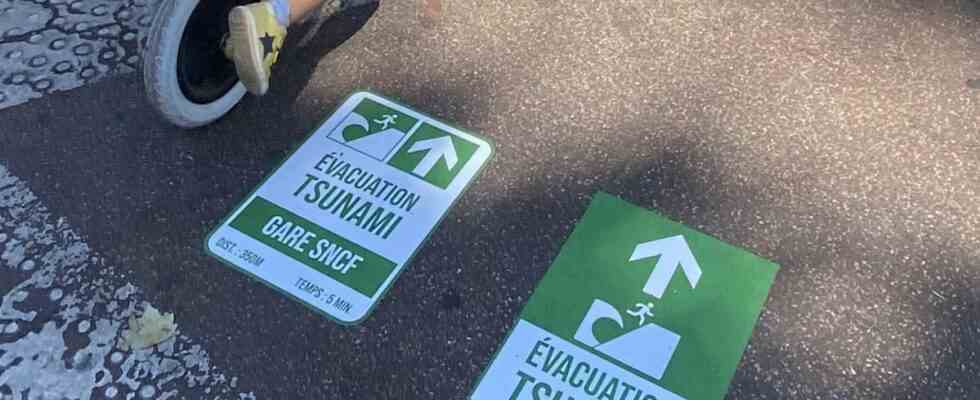“We were on the bus, at City Hall, and everyone’s phones started ringing at the same time. With a very loud noise. The message said ”extreme alert”. And it was written in bold. We were very, very scared. There was a real moment of panic. “Thursday, 4:30 p.m. in Cannes, Lilia, Ambre and Mahée, three high school girls are still all returned. A few minutes earlier, the prefecture of the Alpes-Maritimes launched, as expected in announcements in the press and on the networks, a test of the FR-Alert system about a tsunami which threatened (for false) to hit the coast. .
A first in France in this town at the forefront of the issue, intended to evaluate this device deployed on recent smartphones since last summer but also, according to a head of state services in the department, to “prepare the populations” to “adopt the right reflexes”. “The probability of a wave of one meter, therefore catastrophic, in the next thirty years is very high” on the Mediterranean coasts, noted last year Vladimir Ryabinin, the executive secretary of the Intergovernmental Oceanographic Commission of Unesco.
A concert of strident bells
“We are in front of the sea, we know that it can happen”, testify the three adolescent girls spinning on the alleys of Liberty, where the town hall of Cannes had set up a stand and deployed volunteers to explain the process, and possibly to reassure. At 4:06 p.m., very precisely, around the Palais des Festivals and in another district of the city, to the west, all the smartphones were triggered. Or almost. This system of “cellular broadcasting”, to all subscribers in a given sector, still shows some failures with Free operators and to a lesser extent Orange, we explained on the spot. In any case, all those who were entitled to it received the same notification, in English and in French: “Tsunami alert in the Mediterranean Sea. A tsunami will reach the coast in a few minutes. Evacuate on foot inland. »
Moment of hesitation (no pun intended) between the concert of particularly anxiety-provoking shrill ringtones and the mention “Exercise – Exercise – Exercise” which escaped some people. “I did not see the precision right away so it made me feel weird”, said Frédéric in particular, who received the message when he was near the hospital in Cannes, almost 2 km from the congress center. In a nearby bank, “everyone panicked and wanted to leave”, also explained a witness to this scene.
“Crazy people do anything”
Around the stand installed by the municipality, the alert was also given via the city’s loudspeakers (nearly 330 are installed on the public highway). But it was hardly audible because of the wind blowing on the Croisette. “Did you receive a message that surprised you? Marie-Laure Chenel, member of the Cannes Civic Reserve on all major risks, meets passers-by. She explains the process to René, 82 years old. “Oh you know, in the event of a disaster, people are panicked and do anything,” breathes the retiree. “Precisely, we are here so that things go better if ever, one day, the alert was really given”, replies the volunteer.
Documentation is available. In Cannes, where the subject has been taken head-on by the town hall for a few years, a signage has been affixed to coordinate evacuations. It indicates the points, high up or at a good distance from the coast, to be reached in the event of an alert. In 2017, it was also “the first city in France to organize a simulation exercise as part of its municipal safeguard plan (PCS)”. “The municipality can be very impacted because the altimetry is low”, notes the director of major risks at the town hall, Yannick Ferrand.
“More awareness”
In any case, the threat is real. She has already knocked. In 1887 in particular, after an earthquake which killed 644 people between France and Italy. On October 16, 1979, a wave caused by land subsidence on a construction site south of Nice airport also killed eleven people. According to the most extreme models tested by the Geoazur laboratory, in the event of a “total rupture of the Ligurian fault” with “an earthquake with a magnitude of 7.5”, the breakers could even “reach 4 m in Menton and on the capes, especially in Antibes”, explained, in 2019 to 20 minutes, scientist Laurie Boschetti. The balance would then be in other proportions.
Hence the interest, according to her, “that the people of the Riviera are aware that the risk exists” and that they benefit from “more awareness”. This was the purpose of Thursday’s maneuver, in addition to testing this direct alert on the telephone of those potentially affected. In the message sent, a link referred to a questionnaire. And, an hour after sending, 600 people had already responded, according to the town hall of Cannes. The data, received in real time, will be analyzed by Johnny Douvinet, professor of geography at the University of Avignon, in charge of the study and present yesterday in the city of festivals. On the first testimonies, “52% of people said they were stressed by the alert, 80% had a feeling of surprise and 90% expressed their curiosity”. Figures that will be used to improve the system. Since the deployment of FR-Alert, last summer, 27 exercises had already been organized in France but never yet on the theme of the tsunami.

